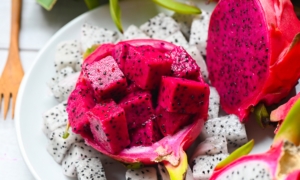Discover the Abundance of Benefits Offered by the Exotic Dragon Fruit

Dragon fruit derives its name from its bright-red skin covered in green scales, resembling a dragon as depicted in Chinese mythology. Various myths connect the fruit to dragons, including one that says it’s a gift from dragons.
There are several varieties of dragon fruit (Selenicereus undatus, formerly called Hylocereus) that come from the climbing cactus family, grown throughout tropical and subtropical regions. Both sweet and sour exist, but the most popular is the red-skin variety with its sweet white pulp dotted with black crunchy seeds. Other varieties have red or yellow pulp. Sometimes referred to as pitaya, they have a slightly sweet taste between those of kiwis and pears.
Benefits
The high level of antioxidants in dragon fruit is one of its best nutritional characteristics. This makes the fruit anti-inflammatory, and it fights free radical damage in our bodies, which we are experiencing more of today because of environmental and lifestyle factors.
The accumulation of free radicals leads to cellular damage and oxidative stress, leading to accelerated aging and diseases such as cancer, cardiovascular disease, and neurodegenerative disorders such as Parkinson’s and Alzheimer’s.
Betacyanins (red pigment) and betaxanthins (yellow and white pigments) are responsible for the color of dragon fruit pulp. These pigments, called betalains, have antioxidant and anticancer properties.
Flavonoids are phytochemical compounds also found in dragon fruit. Along with the high level of vitamin C in this fruit, flavonoids enhance dragon fruit’s powerful antioxidant action.
Heart
Studies show that dragon fruit may help lower LDL cholesterol while improving HDL cholesterol. Dragon fruit peel contains pectin, which studies show may improve cholesterol metabolism and support normal blood pressure.
The tiny black seeds of this fruit are rich in omega-6 and omega-3 fatty acids, which are good for the heart and help lower cholesterol, thus reducing the risks of cardiovascular disease.
The high dietary fiber of dragon fruit is linked with a lower risk of cardiovascular disease.
Cancer
Dragon fruit contains lycopene, a carotenoid related to beta-carotene that contributes to its red color. Studies show lycopene plays a significant role in preventing cancer. In combination with dragon fruit’s vitamin C, lycopene can potentially increase anticancer activity by inhibiting the growth and spread of tumor cells, particularly in breast cancer.
Brain
Magnesium is an essential mineral for brain health. Dragon fruit contains magnesium, which can help treat depression and boost brain function. Magnesium deficiency is found in neuromuscular and psychiatric conditions.
Dragon fruit’s high iron content, required for hemoglobin and red blood cell production, is also critical for brain oxygenation.
Diabetes and Weight
The connection between obesity and diabetes is well documented. The low calories, good fiber, and high water content of dragon fruit mean that it can help manage both of these conditions.
Dragon fruit also has a hypoglycemic property that can help regulate blood glucose levels. One study showed that as the amount of dragon fruit consumed increased, blood sugar levels decreased, suggesting a potential for therapeutic use.
A study using mice on a high-fat diet showed they gained less weight and had reductions in liver fat, insulin resistance, and inflammation when given dragon fruit extract. Another study on mice found that the betacyanins in red dragon fruit reduced insulin resistance and prevented obesity by regulating the growth of beneficial gut bacteria.
Digestion
Both the red and yellow dragon fruits are natural laxatives. Their high fiber content helps in stool formation and excretion. The prebiotic oligosaccharides in dragon fruit help increase good gut bacteria, especially in the colon. These aid digestion and help prevent obesity, cancer, cardiovascular disease, and degenerative conditions.
Skin
The skin-nourishing properties of dragon fruit come from its rich antioxidants. These can help treat sunburn, dry skin, and acne. Its vitamin C content assists the growth of collagen and connective tissue, preventing and speeding up the healing of bruises and wounds. Its high water content is suitable for hydrating dry skin.
A face mask made from pulp mixed with yogurt and applied for 20 minutes can help improve skin health. The mashed pulp can ease sunburn and acne.
Eyes
Beta-carotene, lycopene, and vitamins A and C are all essential for good eye health. According to the Eye Clinic of London, these compounds improve vision by protecting the cornea and reducing the risk of cataracts and macular degeneration.
Bones
Dragon fruit is high in calcium, magnesium, and phosphorus, contributing to stronger bones and good bone health.
Tips for Eating Dragon Fruit
Despite its appearance, dragon fruit is very easy to eat.
- Select a ripe, bright fruit with evenly colored skin.
- Use a sharp knife to cut the fruit in half.
- Use a spoon to scrape out the pulp, or peel the skin and slice the pulp.
- Use in any number of ways, including in smoothies, fruit salads, and salsa.




